Click on images to enlarge
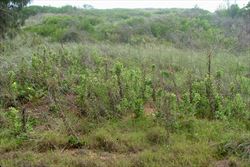
infestation (Photo: Sheldon Navie)
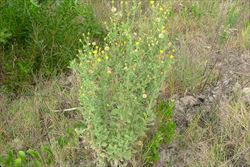
habit (Photo: Sheldon Navie)
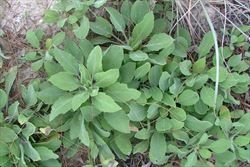
basal rosettes of lower leaves (Photo: Sheldon Navie)

close-up of hairy stem and leaves with lobed bases (Photo: Sheldon Navie)
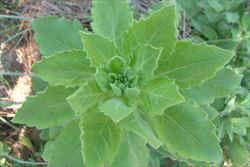
mid-stem leaves with toothed margins (Photo: Sheldon Navie)
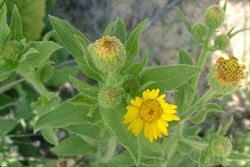
uppermost leaves and young flower-heads (Photo: Sheldon Navie)
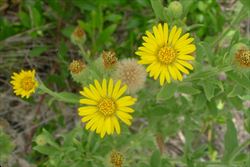
flower-heads (Photo: Sheldon Navie)
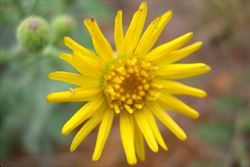
close-up of flower-head (Photo: Forest and Kim Starr, USGS)
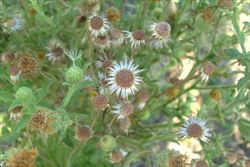
old flower-heads with spreading floral bracts (Photo: Sheldon Navie)
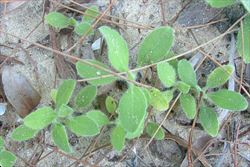
seedlings (Photo: Sheldon Navie)
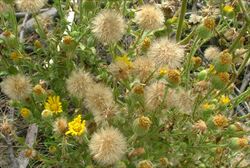
mature flower-heads with 'seeds' (Photo: Sheldon Navie)
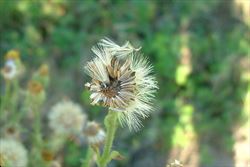
close-up of 'seeds' (Photo: Sheldon Navie)
Scientific Name
Heterotheca grandiflora Nutt.
Family
Asteraceae (Queensland, New South Wales, the ACT, Victoria, Tasmania, Western Australia and the Northern Territory)
Compositae (South Australia)
Common Names
heterotheca, sticky daisy, telegraph weed, telegraphweed
Origin
Native to North America (i.e. south-western USA and northern Mexico).
Naturalised Distribution
Naturalised in some parts of eastern Australia (i.e. in central New South Wales and south-eastern Queensland).
Also naturalised overseas in Hawaii.
Habitat
A weed of costal environs, waste areas, disturbed sites, pastures and bare areas in the sub-tropical and warmer temperate regions of Australia.
Habit
A short-lived (i.e. annual or biennial) herbaceous plant that gives of a strong odour (i.e. it is aromatic). It develops a basal rosette during the early stages of growth and eventually produces upright (i.e. erect) stems that can reach up to 2 m in height.
Distinguishing Features
- a short-lived herbaceous plant that develops a basal rosette of leaves during the early stages of growth.
- it eventually produces upright stems (up to 2 m tall) that are densely hairy and somewhat sticky in nature.
- its alternately arranged leaves (20-80 mm long and 8-35 mm wide) vary in shape depending on their position on the plant.
- its numerous small yellow flower-heads (15-22 mm across) are borne at the tips of the branches.
- its 'seeds' (2-5 mm long) are topped with a ring of several yellowish-brown to reddish coloured hairs (4-7 mm long).
Stems and Leaves
Plants produce one or more upright (i.e. erect) stems that are mainly branched towards the top of the plant. These stems are densely hairy (i.e. pubescent), and many of these hairs are somewhat sticky in nature (i.e. glandular). They are relatively thick, almost round in cross-section, but often slightly ridged (i.e. striated).
The alternately arranged leaves are usually borne on distinct stalks (i.e. petioles) 10-40 mm long. These leaves (20-80 mm long and 8-35 mm wide) are relatively thick, and their shape varies depending on their position on the plant. The lowermost leaves are usually egg-shaped in outline (i.e. ovate) or oblong in shape with bluntly or sharply toothed (i.e. crenate or serrate) margins. Leaves along the middle portion of the stems are usually somewhat narrower (i.e. ovate to oblanceolate) and have more deeply toothed margins (i.e. they are coarsely serrate). These leaves tend to be almost stalkless (i.e. sub-sessile) and often widen to a pair of lobes at their bases. The uppermost leaves are narrower again (i.e. oblanceolate to lanceolate), significantly smaller, have more sharply pointed tips (i.e. acute apices), and usually have entire margins. The upper surfaces of all leaves are somewhat hairy (i.e. sparsely pubescent), while their undersides are usually densely hairy and paler in colour.
Flowers and Fruit
The numerous small daisy-like flower-heads (i.e. capitula) are borne at the tips of the branches. These flower-heads (15-22 mm across) and are bright yellow and are actually made up of numerous tiny flowers (i.e. florets) surrounded by several rows of narrow green bracts that form a cup-like structure (i.e. an involucre) at its base. These bracts (7-9 mm long) are covered in small sticky (i.e. glandular) hairs. In the centre of each flower-head are numerous (50-60) small tubular yellow flowers (i.e. tubular florets) about 4 mm long. Around the edge of each flower-head are 25-35 small 'petals' (i.e. ray florets) 4-8 mm long. Flowers are mostly produced during late summer.
Numerous 'seeds' (i.e. achenes) can be produced by each flower-head (i.e. capitulum). Each of these tiny seeds (2-5 mm long) is topped with a ring (i.e. pappus) of several yellowish-brown to reddish coloured hairs (4-7 mm long).
Reproduction and Dispersal
This species reproduces only be seed. The hairs on these small seeds assist wind dispersal, allowing them to be spread significant distances by sea breezes. Seeds are also known to be dispersed after becoming attached to clothing and animals. They can probably also float on water and may also be dispersed in mud.
Environmental Impact
Telegraph weed (Heterotheca grandiflora) is regarded as an emerging or potential environmental weed in south-eastern Queensland and New South Wales. It grows quickly, is a prolific seed producer, and can form dense infestations, particularly in disturbed or bare areas. In south-eastern Queensland it has already shown a propensity to form dense colonies which pose a threat to the natural vegetation on beaches, foredunes, hinddunes and the understorey biodiversity of coastal plant communities.
In the early 1990's telegraph weed was discovered on The Spit on the Gold Coast in south-eastern Queensland. This infestation has spread, particularly in recent years, and has become common along coastal roadsides and tracks and on sand dunes in this area. It is steadily moving in a northern direction, due to prevailing south-easterly winds, and has recently been found on South Stradbroke Island, Wavebreak Island and along the foreshore at Labrador. The infestations present in Queensland currently cover an area of about 300 hectares in total.
Telegraph weed (Heterotheca grandiflora) has already invaded South Stradbroke Island Conservation Park and has the potential to spread to environmentally significant areas including Moreton, North Stradbroke and Fraser Islands. It is currently the subject of a concerted control program on South Stradbroke Island involving the Queensland Department of Natural Resources and Mines, the Queensland Parks and Wildlife Service and the Gold Coast City Council.
In New South Wales, telegraph weed (Heterotheca grandiflora) is present in the Raymond Terrace-Newcastle area in the Lower Hunter Valley. In this region it grows in pastures and wastelands at some distance from the coast. It is also seen as a potential environmental weed in the coastal areas in northern New South Wales. In Hawaii, telegraph weed (Heterotheca grandiflora) is quite troublesome and grows in a wide range of habitats, including as a pioneer on old lava flows and in poor sandy soils.
Other Impacts
Telegraph weed (Heterotheca grandiflora) is a potential weed of pastures. This species can also be very unsightly when growing along beaches, particularly after it has finished flowering, and dense stands can be difficult to pass through. Tourism is very important in many of the locations that telegraph weed has already infested in Australia, and a decline in the health and aesthetic beauty of these beach areas may have negative impacts on this industry.
Legislation
This species is declared under legislation in the following states and territories:
- Queensland: Class 2 - landowners must take all reasonable steps to keep land free of this species (throughout the entire state). It is also illegal to sell a declared plant or its seed in this state.
Similar Species
Telegraph weed (Heterotheca grandiflora) is similar to false yellowhead (Dittrichia viscosa), stinkwort (Dittrichia graveolens) and the fleabanes (Conyza spp.). These species can be distinguished by the following differences:
- telegraph weed (Heterotheca grandiflora) is an upright short-lived (i.e. annual) herbaceous plant (growing up to 2 m tall) with younger stems, leaves and flower-head bracts that are covered in hairs, some of which are sticky (i.e. glandular). Its relatively large flower-heads (15-22 mm across) have many (25-35) relatively small yellow 'petals' (i.e. ray florets) 5-8 mm long.
- false yellowhead (Dittrichia viscosa ) is a spreading long-lived (i.e. perennial) shrub (0.3-1.5 m tall) with younger stems, leaves and flower-head bracts that are covered in numerous sticky (i.e. glandular) hairs. Its relatively large flower-heads (10-22 mm across) have several to many (12-18) relatively large yellow 'petals' (i.e. ray florets) 10-12 mm long.
- stinkwort (Dittrichia graveolens ) is an upright short-lived (i.e. annual) herbaceous plant (growing up to 1 m tall) with younger stems, leaves and flower-head bracts that are covered in sticky (i.e. glandular) hairs. Its relatively small flower-heads (3-10 mm across) have several (10-12) relatively small yellow 'petals' (i.e. ray florets) 4-7 mm long.
- the fleabanes (Conyza spp.) are upright short-lived (i.e. annual) herbaceous plants (growing up to 2 m tall) but their stems, leaves and flower-heads are not covered in sticky (i.e. glandular) hairs (though they are usually somewhat hairy). Their relatively small flower-heads (usually less than 5 mm across) do not have any obvious 'petals' (i.e. ray florets), although some may have tiny 'petals' (i.e. ray florets) about 1 mm long.

